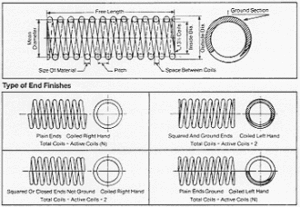 You know how a spring works—but do you know exactly what goes into a spring design in order to make sure it works properly? It’s more complex than you might think. An effective spring design takes precision. Any slight error can render it useless, which in turn, will render your product useless, too. Of course, this is the last thing you want when you’re designing a spring. Your sole goal is to make it work for its intended purpose. You don’t want it to break from too much pressure and you don’t want it not to compress because the load is too light for the strength of the spring.
You know how a spring works—but do you know exactly what goes into a spring design in order to make sure it works properly? It’s more complex than you might think. An effective spring design takes precision. Any slight error can render it useless, which in turn, will render your product useless, too. Of course, this is the last thing you want when you’re designing a spring. Your sole goal is to make it work for its intended purpose. You don’t want it to break from too much pressure and you don’t want it not to compress because the load is too light for the strength of the spring.
There are ways to ensure that your design turns out exactly as you want it to. Here are five steps to designing a high quality spring design.
1. Applied Force
Before you even start your spring design, you’ll need to put in some forethought. The spring you design will need to withstand a certain amount of applied force. So your first step is figuring out exactly how much force will need to be generated to ensure that your spring compresses properly. The applied force will help determine what material you’ll need to use and which size of spring you’ll need.
2. Solid Height
Next comes solid height. This is where all the wires are touching once the spring is compressed as far as it can go. Figuring out your solid height will also be based on the applied force that you’ve calculated in the step above. If your spring compresses to its solid height before all the force is applied, your product won’t work as it’s supposed to.
3. Materials
The wire material you choose will also affect the functionality of your spring. Your design needs to take into account the pros and cons of each type of material based on the intended use of your spring. If you need a heavy-duty spring for an industrial application, then naturally you’re going to need to consider a stronger, thicker material to do the job. If you only need the spring to withstand a light load, like when clicking a pen, then a thinner material will be acceptable.
4. Experienced Manufacturer
Because the calculations that come with custom designs can be complicated and easy to mess up, you should be working with an experienced manufacturer with specialists on staff to help you. The slightest mistake can become a huge problem, so it’s best to make sure your design is accurate right from the start. The guidance and help the manufacturing specialists can provide you will be invaluable to your design.
5. Prototype
For any custom design work, it’s best to reduce the risk of error by getting a prototype created. The prototype stage of your spring design can save you both time and money. Once your design is finished, you can create prototypes of your spring so you can test it in your product to make sure it works as it’s supposed to. If not, you have the chance to change your design while you still have the opportunity to do so before it’s too late.
A Quality Design Takes Consideration
Designing a high quality spring takes careful consideration, precise calculations, and the right expertise. To make sure your design is right, consider the spring’s applied force, solid height, and materials, and get in business with a manufacturer with experience, expertise, and prototyping capabilities.
Belt Tensioner Spring
Learn How We Helped an Automative Parts Manufacturer
Reduce Spring Cost by 20%
